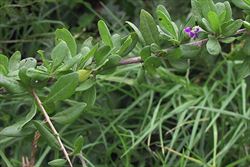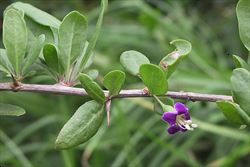Click on images to enlarge

leaves and flower (Photo: Jackie Miles and Max Campbell)

close-up showing stem, spines, leaves and flower (Photo: Jackie Miles and Max Campbell)

close-up of seeds (Photo: Steve Hurst at USDA PLANTS Database)
Scientific Name
Lycium barbarum L.
Synonyms
Lycium chinense Mill. (misapplied)
Family
Solanaceae
Common Names
Barbary matrimony vine, Chinese box-thorn, Chinese boxthorn, Chinese wolfberry, Duke of Argyll's teatree, goji berry, goji plant, Himalayan goji berry, matrimony vine, wolf berry, wolfberry
Origin
Native to China.
Naturalised Distribution
Widely naturalised in eastern Australia (i.e. in south-eastern Queensland, eastern New South Wales, Victoria, Tasmania and south-eastern South Australia).
Notes
Chinese boxthorn (Lycium barbarum) is regarded as an environmental weed in Victoria and Tasmania. This garden escape has mainly become naturalised in coastal and sub-coastal districts in south-eastern Australia. It is often found growing in disturbed sites and waste areas, but also invades riverbanks and native bushland (e.g. Yarra Bend Park in Victoria).
Chinese boxthorn (Lycium barbarum) is very similar to African boxthorn (Lycium ferocissimum) and its distribution and impact in Australia may be under-estimated as a result of it being confused with this species. Like African boxthorn (Lycium ferocissimum), it is dispersed into natural areas by birds and other animals that eat its fruit and may cause similar environmental impacts (e.g. form dense thickets along waterways to the detriment of native species).

